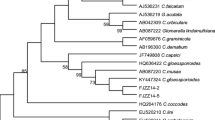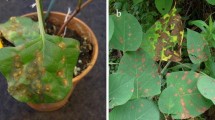Abstract
Colletotrichum nymphaeae is the primary causal agent of strawberry anthracnose in Iran resulting in epidemics in strawberry fields in recent years. Due to the hemibiotrophic nature of the pathogen, early detection in symptomless, infected plants, especially in nurseries could be advantageous for disease management. Assessing inter-species variation by rep-PCR fingerprinting of Colletotrichum spp. within the C. acutatum species complex causing strawberry anthracnose revealed a specific genomic segment amplified with only C. nymphaeae. The amplicon was extracted, purified and novel primer sets were developed based on conventional PCR and loop-mediated isothermal amplification (LAMP) techniques. The genus and species-specific PCR primers were able to discriminate the genus Colletotrichum and C. nymphaeae from other fungal species in pure culture and in assays of diseased, detached leaves. Similar results were observed for LAMP, but it was more sensitive compared to the PCR assay. Using both assays, asymptomatic strawberry plants infected with C. nymphaeae strain CCTUCch32 were readily detected. These results show that the primer sets developed in this study based on conventional PCR and LAMP techniques can be effective for early detection of C. nymphaeae, which can contribute to improved control strategies for strawberry anthracnose.






Similar content being viewed by others
References
Alves, A., Phillips, A. J., Henriques, I., & Correia, A. (2007). Rapid differentiation of species of Botryosphaeriaceae by PCR fingerprinting. Research in Microbiology, 158(2), 112–121.
Baroncelli, R., Zapparata, A., Sarrocco, S., Sukno, S. A., Lane, C. R., Thon, M. R., Vannacci, G., Holub, E., & Sreenivasaprasad, S. (2015). Molecular diversity of anthracnose pathogen populations associated with UK strawberry production suggests multiple introductions of three different Colletotrichum species. PLoS One, 10(6), e0129140.
Baroncelli, R., Talhinhas, P., Pensec, F., Sukno, S. A., Le Floch, G., & Thon, M. R. (2017). The Colletotrichum acutatum species complex as a model system to study evolution and host specialization in plant pathogens. Frontiers in Microbiology, 8, 2001.
Cai, L., Hyde, K. D., Taylor, P. W. J., Weir, B. S., Waller, J., Abang, M. M., Zhang, J. Z., Yang, Y. L., Phoulivong, S., Liu, Z. Y., Prihastuti, H., Shivas, R. G., McKenzie, E. H. C., & Johnston, P. R. (2009). A polyphasic approach for studying Colletotrichum. Fungal Diversity, 39, 183–204.
Chalfoun, N. R., Castagnaro, A. P., & Ricci, J. D. (2011). Induced resistance activated by a culture filtrate derived from an avirulent pathogen as a mechanism of biological control of anthracnose in strawberry. Biological Control, 58(3), 319–329.
Chandra, A., Keizerweerd, A. T., Que, Y., & Grisham, M. P. (2015). Loop-mediated isothermal amplification (LAMP) based detection of Colletotrichum falcatum causing red rot in sugarcane. Molecular Biology Reports, 42(8), 1309–1316.
Damm, U., Cannon, P. F., Woudenberg, J. H. C., & Crous, P. W. (2012). The Colletotrichum acutatum species complex. Studies in Mycology, 73, 37–113.
Edgar, R. C. (2004). MUSCLE: Multiple sequence alignment with high accuracy and high throughput. Nucleic Acids Research, 32, 1792–1797.
Han, Y. C., Zeng, X. G., Xiang, F. Y., Ren, L., Chen, F. Y., & Gu, Y. C. (2016). Distribution and characteristics of Colletotrichum spp. associated with anthracnose of strawberry in Hubei, China. Plant Disease, 100(5), 996–1006.
Hebert, P. D., Stoeckle, M. Y., Zemlak, T. S., & Francis, C. M. (2004). Identification of birds through DNA barcodes. PLoS Biology, 2(10), e312.
Henz, G. P., Boiteux, L. S., & Lopes, C. A. (1992). Outbreak of strawberry anthracnose caused by Colletotrichum acutatum in Central Brazil. Plant Disease, 76, 212.
Hollingsworth, P. M., Forrest, L. L., Spouge, J. L., Hajibabaei, M., Ratnasingham, S., van der Bank, M., Chasee, M. W., Cowan, R. S., et al. (2009). A DNA barcode for land plants. Proceeding of the National Academy of Science of the United State, 106, 12794–12797.
Kandan, A., Akhtar, J., Singh, B., Pal, D., Chand, D., Agarwal, P. C., & Dubey, S. C. (2016). Application of loop-mediated isothermal amplification (LAMP) assay for rapid and sensitive detection of fungal pathogen, Colletotrichum capsici in Capsicum annuum. Journal of Environmental Biology, 37(6), 1355.
Karimi, K., Ahari, A. B., Arzanlou, M., Amini, J., Pertot, I., & Rota-Stabelli, O. (2017). Application of the consolidated species concept to identify the causal agent of strawberry anthracnose in Iran and initial molecular dating of the Colletotrichum acutatum species complex. European Journal of Plant Pathology, 147(2), 375–387.
Karimi, K., Arzanlou, M., & Pertot, I. (2019). Weeds as potential inoculum reservoir for Colletotrichum nymphaeae causing strawberry anthracnose in Iran and Rep-PCR fingerprinting as useful marker to differentiate C. acutatum complex on strawberry. Frontiers in Microbiology, 10, 129.
Martinez-Culebras, P. V., Querol, A., Suarez-Fernandez, M. B., Garcia-Lopez, M. D., & Barrio, E. (2003). Phylogenetic relationships among Colletotrichum pathogens of strawberry and design of PCR primers for their identification. Journal of Phytopathology, 151(3), 135–143.
McCartney, H. A., Foster, S. J., Fraaije, B. A., & Ward, E. (2003). Molecular diagnostics for fungal plant pathogens. Pest Management Science, 59(2), 129–142.
Meyer, W., Mitchell, T. G., Freedman, E. Z., & Vilgalys, R. (1993). Hybridization probes for conventional DNA fingerprinting used as single primers in the polymerase chain reaction to distinguish strains of Cryptococcus neoformans. Journal of Clinical Microbiology, 31, 2274e2280.
Meyer, W., Latouche, G.N., Daniel, H.M., Thanos, M., Mitchell, T.G., Yarrow D., Schönian, G., & Sorrell, T.C. (1997). Identification of pathogenic yeasts of the imperfect genus Candida by polymerase chain reaction fingerprinting. Electrophoresis 18, 1548e1559.
Mills, P. R., Sreenivasaprasad, S., & Brown, A. E. (1994). Detection of the anthracnose pathogen Colletotrichum. In A. Schots, F. M. Dewey, & R. Oliver (Eds.), Modern assays for plant pathogenic fungi: Identification, detection and quantification (pp. 183–189). Oxford: CAB International.
Notomi, T., Okayama, H., Masubuchi, H., Yonekawa, T., Watanabe, K., Amino, N., & Hase, T. (2000). Loop-mediated isothermal amplification of DNA. Nucleic Acids Research, 28, E63.
Nylander, J. A. A. (2004). MrModeltest v2. Program distributed by the author. Uppsala: Evolutionary Biology Centre, Uppsala University.
Rambaut, A. (2009). FigTree v1.3.1. Retrieved from http://tree.bio.ed.ac.uk/software.
Ronquist, F., & Huelsenbeck, J. P. (2003). MrBayes 3: Bayesian phylogenetic inference under mixed models. Bioinformatics, 19, 1572–1574.
Saha, A., Isha, M., Dasgupta, S., & Saha, D. (2010). Pathogenicity of Colletotrichum gloeosporioides (Penz.) Sacc. Causal agent of anthracnose in different varieties of eggplant (Solanum melongena L.) determined by levels of cross-reactive antigens shared by host and pathogen. Archives of Phytopathology and Plant Protection, 43(18), 1781–1795.
Schrader, C., Schielke, A., Ellerbroek, L., & Johne, R. (2012). PCR inhibitors—Occurrence, properties and removal. Journal of Applied Microbiology, 113(5), 1014–1026.
Sreenivasaprasad, S., & Talhinhas, P. (2005). Genotypic and phenotypic diversity in Colletotrichum acutatum, a cosmopolitan pathogen causing anthracnose on a wide range of hosts. Molecular Plant Pathology, 6, 361–378.
Sreenivasaprasad, S., Sharada, K., Brown, A. E., & Mills, P. R. (1996). PCR-based detection of Colletotrichum acutatum on strawberry. Plant Pathology, 45, 650–655.
Staden, R. (1996). The staden sequence analysis package. Molecular Biotechnology, 5, 233.
Tamura, K., Stecher, G., Peterson, D., Filipski, A., & Kumar, S. (2013). MEGA6: Molecular evolutionary genetics analysis version 6.0. Molecular Biology and Evolution, 30, 2725–2729.
Tao, G., & Cai, L. (2013). Molecular diagnosis of Colletotrichum kahawae by loop-mediated isothermal amplification (LAMP). Journal of Plant Pathology, 95, 519–524.
Tao, G., Hyde, K. D., & Cai, L. (2013). Species-specific real-time PCR detection of Colletotrichum kahawae. Journal of Applied Microbiology, 114(3), 828–835.
Taylor, J. W., Jacobson, D. J., Kroken, S., Kasuga, T., Geiser, D. M., Hibbett, D. S., & Fisher, M. C. (2000). Phylogenetic species recognition and species concepts in fungi. Fungal Genetics and Biology, 31(1), 21–32.
Tehranifar, A., & Sarsaefi, M. (2002). Strawberry growing in Iran. Acta Horticulturae, 567, 547–549.
Thanos, M., Schönian, G., Meyer, W., Schweynoch, C., Gräser, Y., Mitchell, T. G., Presber, W., & Tietz, H. J. (1996). Rapid identification of Candida species by DNA fingerprinting with PCR. Journal of Clinical Microbiology, 34, 615e621.
Tomita, N., Mori, Y., Kanda, H., & Notomi, T. (2008). Loop-mediated isothermal amplification (LAMP) of gene sequences and simple visual detection of products. Nature Protocols, 3, 877–882.
Wang, S., Chu, B., Liu, Q., Luo, Y., & Ma, Z. (2017). Development of a sequence-characterized amplified region marker using inter-simple sequence repeats for detection of Puccinia striiformis f. sp. tritici. Journal of Phytopathology, 165(7–8), 442–447.
Wang, N. Y., Forcelini, B. B., & Peres, N. A. (2019). Anthracnose fruit and root necrosis of strawberry are caused by a dominant species within the Colletotrichum acutatum species complex in the United States. Phytopathology, 109(7), 1293–1301. https://doi.org/10.1094/PHYTO-12-18-0454-R.
White, T. J., Bruns, T., & Taylor, J. (1990). Amplification and direct sequencing of fungal ribosomal RNA genes for phylogenetics. In M. A. Innis, D. H. Gelfand, J. J. Sninsky, & T. J. White (Eds.), A guide to molecular methods and applications (pp. 107–123). New York: Academic Press.
Whitelaw-Weckert, M. A., Curtin, S. J., Huang, R., Steel, C. C., Blanchard, C. L., & Roffey, P. E. (2007). Phylogenetic relationships and pathogenicity of Colletotrichum acutatum isolates from grape in subtropical. Australiaisian Plant Pathology, 56(3), 448–463.
Zhang, X., Harrington, T. C., Batzer, J. C., Kubota, R., Peres, N. A., & Gleason, M. L. (2016). Detection of Colletotrichum acutatum sensu lato on strawberry by loop-mediated isothermal amplification. Plant Disease, 100(9), 1804–1812.
Acknowledgements
We are grateful to Iran National Science Foundation (INSF) and University of Tabriz, Iran for financial support. The research reported here is also partially funded by the Autonomous Province of Trento.
Author information
Authors and Affiliations
Corresponding author
Ethics declarations
Conflict of interest
The authors declare that they have no conflict of interest.
Human and animals rights
No human and/or animal participants were involved in this research.
Informed consent
All authors are consent to this submission.
Electronic Supplementary Material
ESM 1
(DOCX 195 kb)
Rights and permissions
About this article
Cite this article
Karimi, K., Arzanlou, M. & Pertot, I. Development of novel species-specific primers for the specific identification of Colletotrichum nymphaeae based on conventional PCR and LAMP techniques. Eur J Plant Pathol 156, 463–475 (2020). https://doi.org/10.1007/s10658-019-01895-9
Accepted:
Published:
Issue Date:
DOI: https://doi.org/10.1007/s10658-019-01895-9




